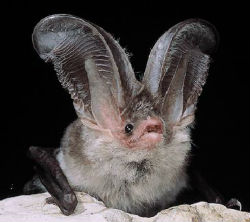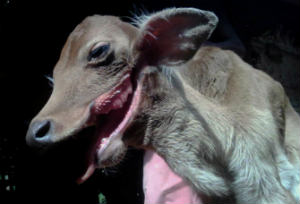Vesper Bat Hybrids
Family Vespertilionidae
Mammalian Hybrids
EUGENE M. MCCARTHY, PHD GENETICS, ΦΒΚ

|
|
Plecotus Credit: Mauro Mucedda |
Eptesicus fuscus [Big Brown Bat] ENHR(w U.S.) Neubaum et al. (2007) report ongoing hybridization in Colorado between eastern and western populations of this bat, which have mtDNA haplotypes differing by more than 10% at the nucleotide sequence level (as much as many other mammals treated as separate species).
Eumops dabbenei [Big Bonneted Bat]
× Eumops underwoodi [Underwood’s Bonneted Bat] Myers and Wetzel (1983) predict that intermediate (hybrid) populations will be discovered in Panama and Costa Rica. None have as yet been reported.
Eumops perotis[Greater Bonneted Bat]
× Eumops underwoodi [Underwood’s Bonneted Bat] CON: southwestern U.S. (southern Arizona) and adjacent Mexico (northern Sonora). A specimen in the Museum of Southwest Biology, taken at Deer Valley School, Maricopa Co., Arizona, was classified by Eger (1977, p. 57) as E. underwoodi, but by Hoffmeister (1986, p. 121) as E. perotis. However, neither suggests it is a hybrid.
Eumops underwoodi [Underwood’s Bonneted Bat]
See: Eumops dabbenei; E. perotis.
Laiurus intermedius [Northern Yellow Bat] Two populations (floridanus, intermedius), treated as races of this bat, hybridize in coastal Texas (southern U.S.). Although long treated as separate species, Dasypterus floridanus (Florida Yellow Bat) and D. intermedius (Yellow Bat), they have usually been treated as conspecific since they were lumped by Hall and Jones (1961) due to hybridization. Hall and Kelson 1959 (p. 193); Handley (C. O.) 1959, 1960; Lowery 1936, 1943 (pp. 223-224), 1974 (p. 125); Webster et al. 1980 (p. 3).
Myotis adversus [Large-footed Myotis]
× Myotis muricola [Whiskered Myotis]ENHI. CON: southeast Asia, Indonesia, Philippines, Taiwan. Bat expert George Edward Dobson (1876, p. 136) suggested lumping Vespertilio blanfordi and V. amboinensis under V. muricola due to the existence of many intermediate specimens. Specifically, he says “V. blanfordi and V. amboinensis appear to represent the extreme varieties of form in this species. … Between these two forms, however, a great number of intermediate forms occur, which render it impossible, in my opinion, to regard them as distinct species.” Today, Vespertilio blanfordi is a synonym of Myotis muricola, but V. amboinensis is a synonym of M. adversus. Therefore, a great number of intermediates (i.e., probable hybrids) exist between M. adversus and M. muricola.
Myotis albescens [Silver-tipped Myotis]
× Myotis nigricans [Black Myotis] Husson (1978, p. 174) says Vespertilio arsinoë Temminck, 1827-1841 (1835-1841, vol. II, pp. 247-248), of which the type specimen (from Surinam) is in the Leyden Museum, is a synonym of Myotis albescens. Dobson (1878, p. 328) says V. arsinoë,
Appears to be quite intermediate between V. nigricans [i.e., Myotis nigricans] and V. albescens [i.e., Myotis albescens], resembling the former in the shape of its ears and in size, the latter in the form of the tragus, in the larger feet, free extremity of the tail, and in the peculiar colour of the fur. Ears shorter than the head laid forwards their extremities do not reach the end of the muzzle; inner margin of the conch convex, outer margin concave in upper half, becoming gradually convex in the lower half; tip rounded off, slightly projecting outwards: tragus rather short and straight, subacutely pointed, not attenuated towards the tip.
Wings from the base of the toes; feet intermediate in size between those of V. nigricans and V. albescens; calcaneum terminating in a projecting tooth; the last osseous caudal vertebra free.
Fur very similar in surface colour to that of V. albescens, but darker above, the hairs being almost black, the extreme tips on the shoulders and back shining yellowish; beneath, dark brown or black at the base and for three fourths the length of the hairs, the terminal fourth of the hairs on the chest and abdomen, and the terminal half of the fur about the pubis and thighs, ashy.
This morphological intermediacy suggests arsinoë as a PHP of this cross.
Myotis auriculus [Southwestern Myotis]
× Myotis evotis [Long-eared Myotis] A narrow parapatric contact zone exists in the southwestern U.S. (e Arizona, w New Mexico). No hybrids as yet reported. Warner 1982 (p. 3).
Note: Probable hybrids between two populations (californicus, stephensi), usually treated as races of Myotiscalifornicus, occur in Arizona. Hoffmeister 1986 (p. 87).
Myotis californicus [California Myotis]
× Myotis leibii [Eastern Small-footed Myotis] ENHI(southwestern U.S.)? The frequent occurrence of morphologically intermediate specimens makes these taxa hard to separate. There may be an ACZ (M. leibii occurs above M. californicus). Hoffmeister 1986 (pp. 84-87).
Myotis evotis [Long-eared Myotis] See: Myotis auriculus.
Myotis leibii [Eastern Small-footed Myotis] See: Myotis californicus.
Myotis lucifugus [Little Brown Myotis]
× Myotis occultus [Arizona Myotis] ENHR. CON: western U.S. Specimens from southern Colorado and northern New Mexico are geographically and morphologically intermediate. Barbour and Davis 1970; Findley and Jones 1967; Hoffmeister 1986; Piaggio et al. 2002 (p. 392).
× Myotis yumanensis [Yuma Myotis] ENHR. CON: western U.S. The taxon phasma, treated as a race of M. lucifugus, is probably based on hybrids of this type. Barbour and Davis 1979 (p. 43); Harris 1974; Herd 1984; Herd and Fenton 1983; Parkinson 1978, 1979.
Myotis macrotus [Southern Myotis]
× Myotis moluccarum [Northern Myotis] ENHR(northeastern Australia). Until 1995, these bats were treated as conspecific, together with the Indonesian M. adversus (Large-footed Myotis). Then Kitchener et al. split them. More recently, Cooper et al. suggested that macrotus and moluccarum again be lumped due to hybridization (in Queensland, north of Townsville), but that adversus still be treated separately. Cooper et al. 2001; Kitchener et al. 1995.
Myotis moluccarum [Northern Myotis] See: Myotis macrotus.
Myotis muricola [Whiskered Myotis]See: Myotis adversus.
Myotis nigricans [Black Myotis] See: Myotis albescens.
Myotis occultus [Arizona Myotis] See: Myotis lucifugus.
Myotis yumanensis [Yuma Myotis] See: Myotis lucifugus.
Pipistrellus hesperus [Western Pipistrelle] In southwestern Arizona probable hybrids between two populations (hesperus, maximus), treated as races of P. hesperus, are known from Cochise and Graham counties. Where these two populations meet in the Animas Mountains there is an abrupt shift in size (the primary difference between these types). Hoffmeister 1986 (p. 93).
Pipistrellus pipistrellus [Common Pipistrelle]
× Pipistrellus kuhlli [Kuhl’s Pipistrelle] NHR?? CON: Europe and western Asia. Bat expert Carl Jakob Wilhelm Ludwig Koch suspected an animal he once owned to be a hybrid of this kind. Ackermann (1898, p. 78).
× Pipistrellus nathussii [Nathusius’s Pipistrelle] NHR?? CON: Europe and western Asia. Ackermann (1898, p. 78) mentions that Carl Jakob Wilhelm Ludwig Koch, an expert on bats, thought Nannugo (= Pipistrellus) minutissimus Kolenati (1860, p. 77) might well be based on hybrids of this type.
Pipistrellus kuhlli [Kuhl’s Pipistrelle] See: Pipistrellus pipistrellus.
Pipistrellus nathussii [Nathusius’s Pipistrelle] See: Pipistrellus pipistrellus.
Plecotus macrotis [Lump-nosed Bat]
× Plecotus rafinesquii [Rafinesque’s Big-eared Bat] ENHR(southeastern U.S.). A hybrid zone extends from northwestern Mississippi to north-central North Carolina. These bats were treated as separate species until Handley (1959) lumped them due to hybridization. Jones 1977; Lowery 1974 (p. 132).
By the same author: Handbook of Avian Hybrids of the World, Oxford University Press (2006).
 A dog-cow hybrid?
A dog-cow hybrid?